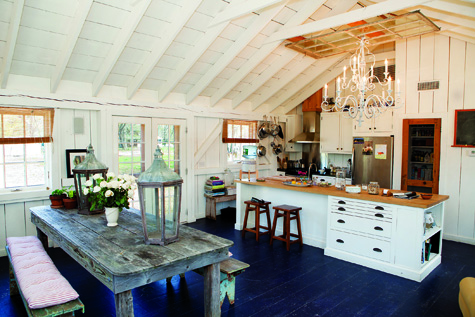Real Estate: 19th century barn transformed into country estate

When Richard Cifarelli acquired a handsome barn back in 1996, he knew it was going to be quite a project to turn it into a home.
“It wasn’t usable at all,” said Mr. Cifarelli, who, as a senior agent with Prudential Douglas Elliman, knows a thing or two about real estate. “There was no water, no electricity. It was about as raw a piece property as you could imagine.”
The 19th-century barn, immediately recognizable by its 60-foot height, gambrel roof and distinctive cupola, is located on the south side of Main Road in Cutchogue. It was once owned by the Fleet family, which had a grand house (now gone) with matching cupola close by the barn.
Mr. Cifarelli says the barn was originally used to house horses and, indeed, according to Munsell’s “History of Suffolk County,” in the 1880s Henry L. Fleet was renowned both as a horse breeder and as the biggest farmer in the Town of Southold.
The book describes Mr. Fleet as having “raised a number of colts and horses which sold at prices ranging up to several thousand dollars, and has at the present time a very superior stock of young horses, from which similar returns may be expected.”
Later on in its history, the barn was used in the flower business of another member of the Fleet family, who sold gladioli from the building, advertising the flowers on an old horse carriage as the “Wayside Flower Stand.”
By the 1990s, though, the barn had fallen into disrepair.
“Probably nothing was done with it for 30 years or so,” said Mr. Cifarelli. “There were gaping holes in the roof.”
Although he had a vision for the barn, Mr. Cifarelli did not dive right into a major renovation project. Instead, he took his time getting to know the property.
“I owned it a long time before I started working on it,” he said. “You walk around a lot, you check where the sun comes in and that’s where you put the kitchen.”
After major work was completed — Mr. Cifarelli estimates that around 80 percent of the barn is new — 1,100 square feet of living space had been created. He moved into the two-bedroom space in 2007 and says the barn is still a work in progress.
In that regard, Mr. Cifarelli plans to turn the rear of the building into living space and convert the current residential area into additional bedrooms.
“I’m going to build a three-car garage, there will be a courtyard to the east and a pool will go in just off the back of the barn,” he said. “It’s 2 1/2 acres, so it’ll be a small estate.”
And, indeed, the exterior of the barn and surrounding grounds already possess a rather European country-estate look by virtue of privet hedges and a paved stone driveway.
It’s kind of a French and Tuscan mix,” said Mr. Cifarelli. “I also wanted low maintenance and although the privet was expensive, there’s not that much upkeep going forward apart from mowing the grass.”
[nggallery id=64 template=galleryview]
The living area’s interior is paneled in wood, some of which was originally on the outside of the barn, and painted a creamy white. The plank floor was also painted white “and then we painted it a Ralph Lauren blue which, with the original white coming through, makes it look quite old,” said Mr. Cifarelli.
The result is a relaxed country space flooded with light and offering comfortable bentwood armchairs and couch to sink into. Fresh flowers, paintings and prints abound, along with a collection of horseshoes propped up on shelves and an ancient porch support casually leaning against a wall.
One quirky touch is the huge creamy-colored chandelier suspended from an old glass-paned door attached to the post and beam ceiling.
“Double the light gets reflected in the glass panes,” observed Mr. Cifarelli.
Mr. Cifarelli seems remarkably calm as he describes the labor of love, but he is the first to admit the project has had its share of stress.
“I moved to Miami for a year and a half right in the middle of it,” he said. “Then I came back and finished it enough to be able to move in.”
He knows there’s still a substantial amount of work to be done, but Mr. Cifarelli remains committed to his work in progress.
This is just what I wanted for my home,” he said. “I lived in Europe and so I really don’t like a typical sheet-rocked house. And I grew up with a barn in my backyard.”








